If you’re planning a trip to Tuscany, the charming city of Pisa should definitely be on your itinerary. From the iconic Leaning Tower to the stunning Piazza dei Miracoli, Pisa offers a wealth of attractions and things to do that are sure to impress.
But Pisa is not just about its famous landmarks or the Leaning Tower.
The town of Pisa itself is a charming. There are pretty pretty piazzas, historic buildings, and museums.The city also boasts a rich history, vibrant culture, and delicious food scene.
In this guide, I’ll take you through the top attractions and best things to do in Pisa, so you can make the most of your visit to this fascinating town.

A Short History of Pisa
Pisa began life as a modest seaside settlement around 1000 BC. Because Pisa was located on the Arno River, Pisa’s military, commercial, and political importance grew. Pisa traded with the prevailing Islamic powers and collected remnants of classical Rome.
By the 11th century, Pisa was a maritime and cultural powerhouse in the Mediterranean, home to illustrious names like Galileo and the celebrated mathematician Leonardo Fibonacci. The only real rival to Pisa at this juncture was Venice.
Naturally, like any prosperous medieval Italian city, Pisa wanted to advertise its new wealth and power. It began to invest in the construction of showy buildings.
After sacking Palermo in 1063, Pisa needed a place to display the treasures and plunder adventurers brought back from Sicily. They decided to construct the “Field of Miracles.”
The bell tower was intended to be the tallest of its age. And that may have come to pass, if circumstances hadn’t thrown a wrench into the town’s best laid plans. Pisa means “marsh lands.”
Unfortunately, the architects didn’t take that into consideration when building their lavish treasures. The bell tower, now called the Leaning Tower, and the Baptistery both began to lean.
In 1284, Pisa’s naval fleet was vanquished by its rival Genoa. After that, Pisa’s power gradually declined. Under the Medici family, Florence captured Pisa in 1406 and held the town until the 1860.
Even today, there’s hostility between Florentines and Pisans. It’s one of Italy’s famous “hate triangles”, nationalistic rivalries that developed between city states vying for power.
Florentines have a saying “Better a death in the family than a Pisan on your doorstep.” Pisans respond “That God grant your wish.”
But Pisa is still a heralded university town. Even Galileo studied in Pisa before being summoned to Florence by the Medici. Legend holds that Galileo even conducted scientific testing on the principles of gravity from atop the Leaning Tower.
Top Attractions In Pisa Italy
Here are the top 10 things to see and do in Pisa, which you should be able to fit into one day in Pisa.
1. Field of Miracles
The #1 attraction is Pisa is the awe-inspiring Field of Miracles itself. When you clap eyes on its creamy assemblage of marble sheathed buildings, you’ll likely gasp and conclude that Pisa deserves the hype. You may want to book a 2 hour all inclusive tour to explore the monuments on the Field of Miracles.
Here are the best things to do and see on the splendid square, which include three vastly under visited museums:
- The Leaning Tower
- The Duomo di Pisa
- The Baptistery
- The Monumental Cemetery
- Duomo Museum
- Museum of Sinopie
2. The Leaning Tower of Pisa
The Leaning Tower is the most famous attraction in Pisa. But the monument isn’t the star of the show. By a long shot.
The Leaning Tower is mostly just a reconstructed bell tower near the Duomo. There are far better bell towers in Europe.
The Leaning Tower is more of a “look at me, look at me” oddity. It’s been overhyped as one of Italy’s must see monuments. It doesn’t deserve the accolades.
Despite that, the Leaning Tower is incredibly popular and crowded. If you want, climb the spiral staircase for magnificent views.
But you have to book a ticket in advance to ensure a spot. You may want to do this weeks ahead of time, to ensure a timed entry slot.
Here are some facts about the Leaning Tower:
- It’s almost 200 feet tall, 55 feet wide, and weighs 14,000 tons.
- There are 8 stories and 6 stories of columns.
- You’ll have to hoof it up 294 steps to get to the belfry.
- 135 of the 180 marble columns have been replaced.
- It’s currently leaning 15 feet off its vertical axis.
- There are 7 bells at the top that weight over 23,000 pounds.
- It’s not the only leaning bell tower in Pisa. San Nicola Church’s tower also leans.
- Galileo proved the theory of gravity by dropping weights from the tower.
To the town’s chagrin, the Leaning Tower started to lean almost immediately after construction. Why does it lean? For the complete scoop, click here.
But, in short, the famed Leaning Tower is the product of poor engineering and architecture bungling. The architects failed to take into account Pisa’s soft sandy soil.
Interventions have forestalled the Leaning Tower’s collapse. But it’s still unstable.
As long as you’re in Pisa, take the requisite cheesy selfie with yourself holding up the Leaning Tower. You can also climb the tower for views.
It’s quite very expensive at 18 euros. And it’s a fairly steep spiral staircase with 294 steps to the top. The steps are slippery and irregular.
The tower is limited to 45 people in a 15 minute time slot. But you’ll be rewarded with beautiful views from the top.
3. The Duomo | Pisa Cathedral
The real gem of the Field of Miracles, and the top attraction in Pisa, is Pisa’s exuberant Duomo. It’s a wonderful example of Pisan Romanesque architecture. You may want to take a guided tour to get the full lowdown.
Like most duomos, it’s dedicated to St. Mary of the Assumption. Pisa’s Duomo is the most ancient church in Italy. It’s older than the cathedrals in Siena and Florence.
Construction of this doughty edifice began in 1063. The main architect for the project was Buscheto, who’s buried in a blind arch on the facade.
The Duomo’s facade is decorated with alternating black and white marble stripes, quarried from Carrara. The lowest level consists of a “blind arcade,” where a series of arches are attached to a wall. Above this are a series of smaller superimposed arcades. The color of the columns are intentionally varied, consistent with the Romanesque style.
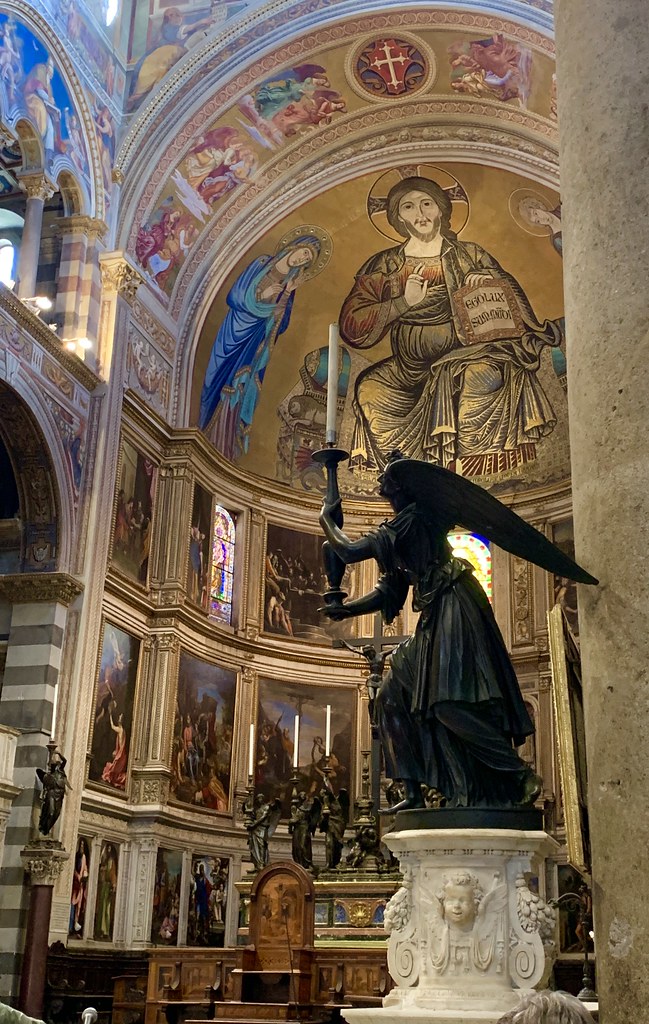
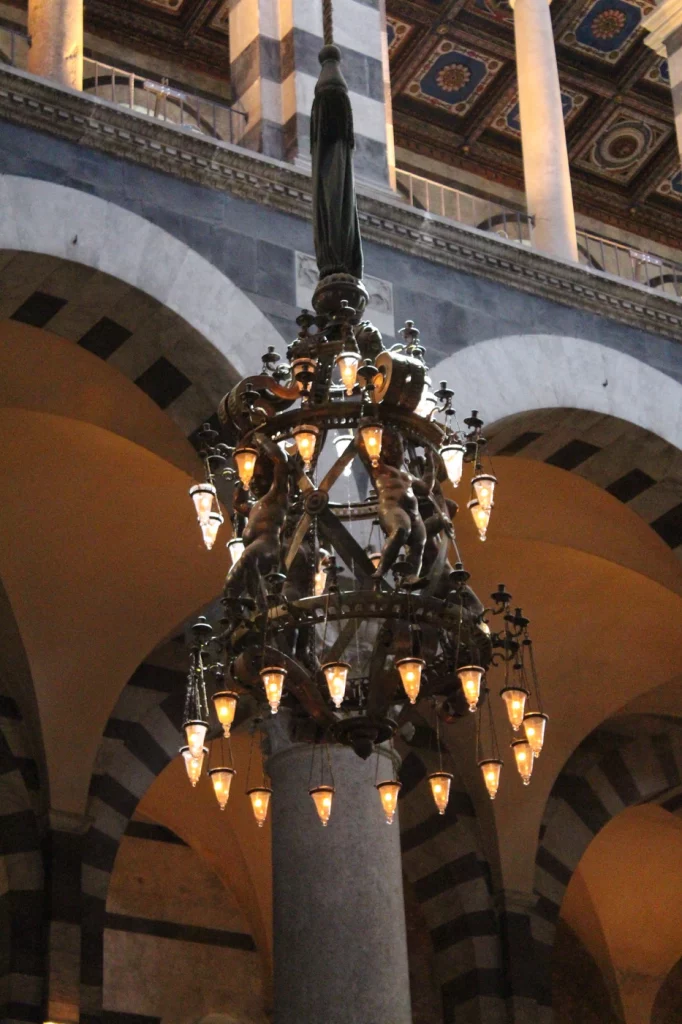
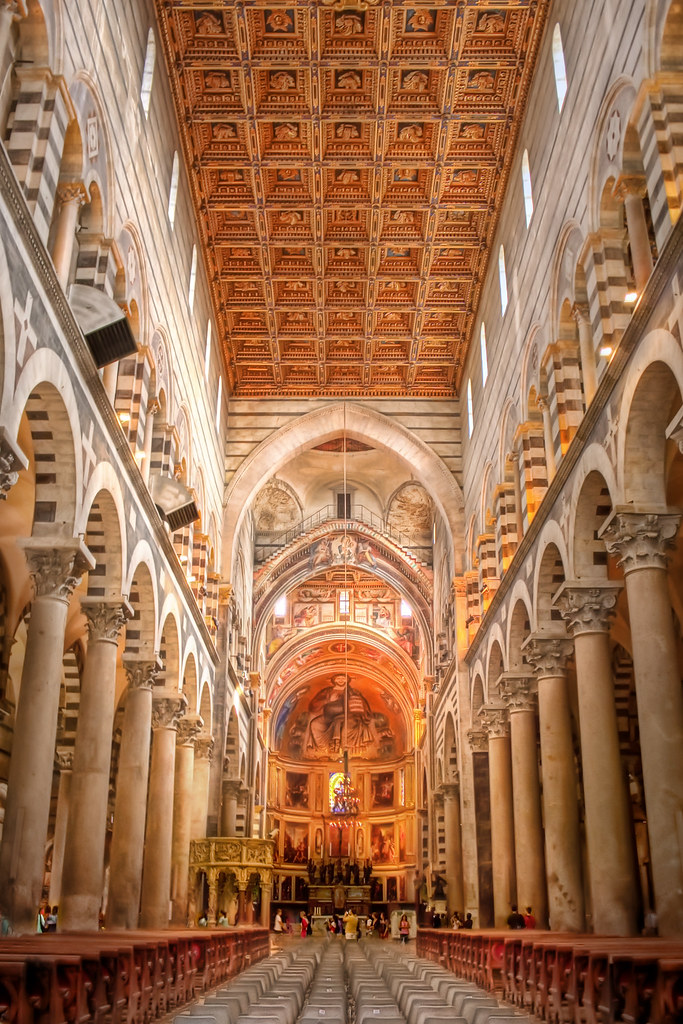
Heavy bronze doors guard the entrance. The main door was designed by students of famed Italian Mannerist sculptor Giambologna, whose masterpiece is in the Loggia dei Lanza in Florence. Above them, there are four rows of open arcades with delicate columns.
Inside, there’s a Latin cross plan with an unusual 5 aisles plan — a spacious central nave and two flanking aisles on each side. The granite Corinthian columns and arches dividing the aisles are ancient Roman.
You’ll find Roman inscriptions in the spoglia, or spoils, that Pisans brought back from conquests and incorporated into the Duomo architecture.
In 1595, a fire destroyed the Duomo’s original medieval art. So the church is mostly decorated with Renaissance paintings, including paintings by Ghirlandaio on the Tomb of Emperor Henry VII. Flanking the entrance to the choir are bronze angels carved by the Florentine Mannerist sculptor Giambologna.
In the conch of the apse, you’ll find mosaics attributed (perhaps erroneously) to the great late 13th century painter, Cimabue.
The apse depicts Christ enthroned, flanked by the Virgin Mary and St. John the Evangelist. There’s also a beautiful wooden coffered ceiling painted with gold leaf.
By far the most important piece inside the Duomo is the elaborate Gothic pulpit carved by Giovani Pisano in the early 14th century. The 8 sided polygonal pulpit, symbolizing the virtues, is curved and adorned with intricately carved relief sculptures showing New testament themes.
Legend holds that Pisano’s work inspired Michelangelo. The pulpit is the finest example of Italian Gothic sculpture anywhere. Except perhaps for his father Nicola Pisano’s pulpit in Siena Cathedral.
Pisa’s Duomo is also forever associated with Galileo. Galileo is Pisa’s native son and the founder of modern physics. While gazing at the “Lamp of Galileo” in the Duomo, he discovered the law of perpetual motion.
Entrance to the Duomo is free. If you have a ticket for another Field of Miracles site, that will get you into the Duomo. But there will likely be a long line to enter.
If you didn’t buy any Field of Miracles tickets, you’ll have to pick up a free timed entry pass at one of the ticket offices to enter the Duomo. These passes are limited in number.
4. The Duomo Museum
Don’t miss the well-curated Duomo Museum, officially called the Museo dell’Opera del Duomo. The museum is right next to the Leaning Tower. The museum opened in 1986 and is housed in a former Capuchin convent.
It recently underwent five years of renovation and modernization between 2014 and 2019. Despite its small size, the museum is a veritable treasure trove — an airy and well-labeled cross section of six centuries of late medieval and early Renaissance Pisan art.
The Duomo Museum houses art, sculptures, artifacts, silver work, embroideries, and decorations. The items were removed and preserved from the Duomo and Baptistery due to atmospheric pollution. (Some were removed in the unpolluted 19th century too.)
They include works by Nicola Pisano, Giovanni Pisano, Tino di Camaino, Andrea Pisano, Nino Pisano, and Andrea Guardi (Donatello’s most active pupil in Pisa).
READ: Guide To Donatello’s Masterpieces
The must see highlights include the 12th century Bonanno Door (where your visit starts), an altar by Giovanni Pisano, a rare 12th century bronze griffin, and the Borgognone Christ.
A very nice piece is Giovanni Pisano’s ivory Madonna and Child sculpture. The sculpture is nicknamed the ”Madonna of the Conversation” for her eye-to-eye pose with her precocious child.
The museum also has a tranquil cloister garden. From there, you have crowd free views of the Leaning Tower. Then, head down to the ground floor to see fine Pisan sculptures in the cloister.
Displayed in bays, these colossal busts once crowned the Baptistery. Like so much else in Pisa, they were made by the young Giovanni Pisano, who clearly left his mark on the Field of Miracles.
Perhaps the museum’s most important piece is a bust of Julius Caesar that you’ll recognize from history class.
Art historians estimate that it was sculpted either during Caesar’s lifetime or within 20 years of his assassination — suggesting that the artist knew what the great conqueror really looked like.
5. The Baptistery
Another great attraction in Pisa is the pretty circular monument in front of the Duomo, the Baptistery. Begun in 1153, this marble giant appears to be dripping in lace, it’s so ornate.
The structure was designed by Diotisalvi. Inside, there’s still a full immersion baptismal font, where Galileo was baptized.
And there’s another beautifully carved pulpit, this one created by Giovanni’s father Nicola Pisano. It’s considered one of the first works of Renaissance art.
Pisano studied ancient Roman works, and you can see the classical influence (characteristic of Renaissance art) in his pieces. Some figures even wear tunics. Mary has the headdress of a Roman matron.
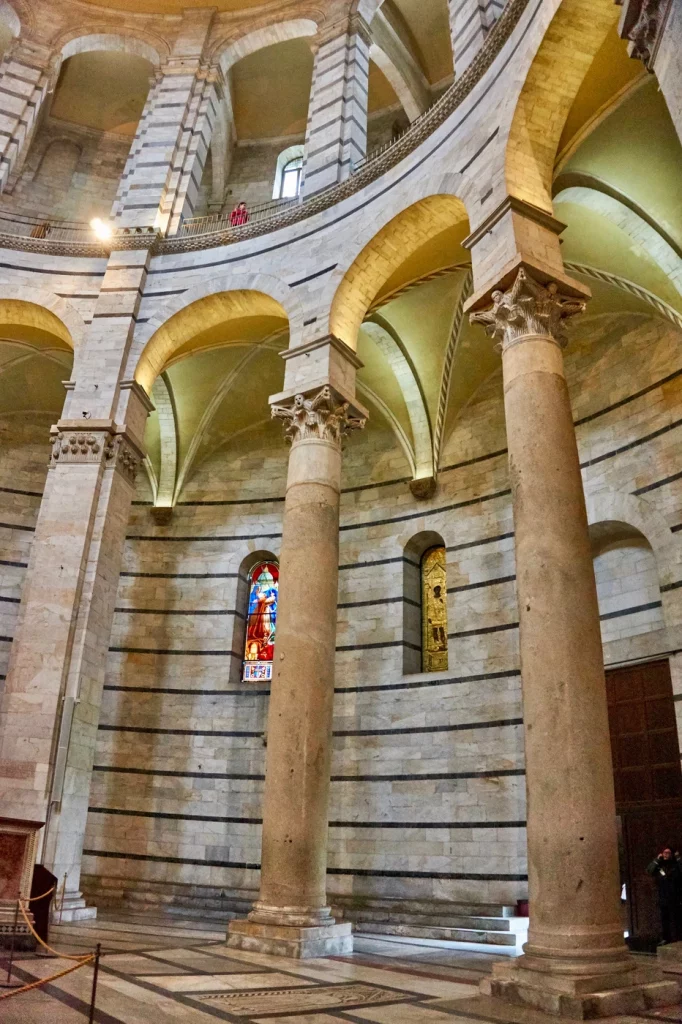
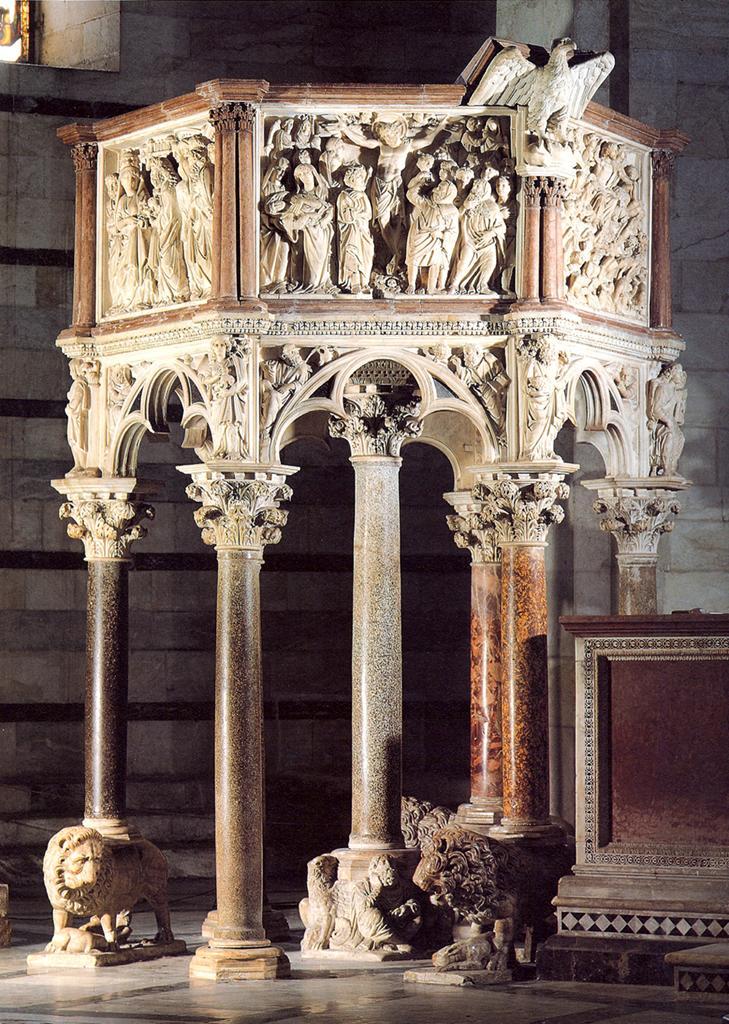
The dome covering the Baptistery is actually two domes. The ceiling is essentially a cone. Covering that cone is the more standard curvilinear dome. Because of the cone, sound waves travel up through the cone and come radiating back down.
This design produces an odd acoustical, or echoing, effect. This was likely an intentional design, to amplify sounds to mimic a pipe organ.
For a tip, the guards will sing and you can hear the melodic reverberations. Like the Leaning Tower, the Baptistery is on unstable soil and leans slightly toward the Duomo.
For views of the Field of Miracles, climb to the viewing level.
6. The Monumental Cemetery | Camposanto Monumental
The Camposanto Monumental, or holy field, is actually one of the best things to visit on the Field of Miracles. It’s a rectangular structure that’s a beautiful and serene enclosed cemetery.
The cemetery was established in 1277 and completed in the 15th century. With gleaming white marble, it functioned as a burial ground for Pisa’s elite until the 1800s.
In the courtyard, ancient sarcophagi line the lower part of the walls. The floors are paved with worn tombstones. The walls were once covered in delicate 14th and 15th century Renaissance frescos, said to be the largest such group in the world. Art historians referred to the courtyard as the “Sistine Chapel of Pisa.”
During WWII, in 1944, the cemetery was badly damaged by Allied bombing and fires. Lead from the roof melted and dripped onto the marble floors and passageways, leaving them pitted and uneven.
The frescos were also heavily damaged and sculptures destroyed. A high tech restoration of the frescos has been ongoing for decades.
The most famous fresco cycle is the gory The Triumph of Death, executed in the 1330s. The frescos are attributed to either Buonamico Buffalmacco or Francesco Traiani.
Though, after years of conjecture and waffling, the consensus seems to be that the author was Buffalmacco. Incidentally, Buffalmacco appears as a character in Boccaccio’s Decameron.
The frescos are didactic, teaching the viewer that death is imminent and you need to live a Christian life or else face repercussions. The frescos are also quite explicit. Angels of death collect corpses. You’ll see disemboweled colons and snakes wrapped around necks.
The fresco cycle pre-dates the Black Death (or plague) of 1348. But the frescos are similar in tone and style to the Black Death frescos of Sienese masters Pietro and Ambrogio Lorenzetti — The Allegory of Good and Bad Government — in Siena’s Palazzo Pubblico.
7. Museo delle Sinopie | Museum of the Sinopias
This Museo of the Sinopias is a quiet reprieve from hubbub of the Leaning Tower. It highlights original 14th century preparatory drawings and rough sketches from the Monumental Cemetery called “sinopie” or “sinopia.”
Sinopia were the first step in making a fresco. The museum’s sinopia were found beneath the cemetery’s frescos after the damage from WWII bombings and were subsequently removed.
For many visitors, the Sinopie Museum may be skippable. But for art lovers and art historians, the Sinopie Museum is a rare delight.
It’s one of the largest collections of original sinopie in the world. You should visit this museum before heading over to the cemetery to inspect the restored frescos that were created from the sinopies.
There’s also a ticket office in the Sinopie Museum. Since it’s very quiet, this is a good place to grab a combination ticket for the Field of Miracles without lines.
The museum also has an educational video about the history and attempts to repair the Leaning Tower. The ticket for the Sinopie Museum is a paltry one euro.
8. Pisa’s Historic Town Center
Don’t restrict your visit to the Field of Miracles! When you’re done with the major attractions in Pisa, visit the historic town itself and take a stroll along the Arno River.
You may want to book a 2 hour guided walking tour of the pretty town. Or relax on a 2 hour food tour.
Pisa has an enviable portfolio of Romanesque buildings, Gothic churches, and lively piazzas and cafes. The main drag in town is the Corso Italia, a gorgeous street.
The Piazza Chiara Gambacorti is filled with orange-toned buildings and palazzos.
There’s the small Church of Santa Maria della Spina. It’s a jewel of Gothic architecture. The white marble facade is ornate, decorated with statutes.
The church is reputed to have a reliquary in the form of a thorn taken from Jesus’s crown of thorns. Inside is the Madonna of the Rose painting by Andrea and Nino Pisano. On one wall, you can also gaze at the last mural ever painted by Keith Haring, Tuttomondo.
Pisa’s second main square is the Knight’s Square. It’s so elegant, it should be a mandatory stop, not just an accidental occurrence after you see the Field of Miracles.
The square was once Pisa’s seat of government. You’ll find an old clock building, the university, and the elegant Church of San Stefano.
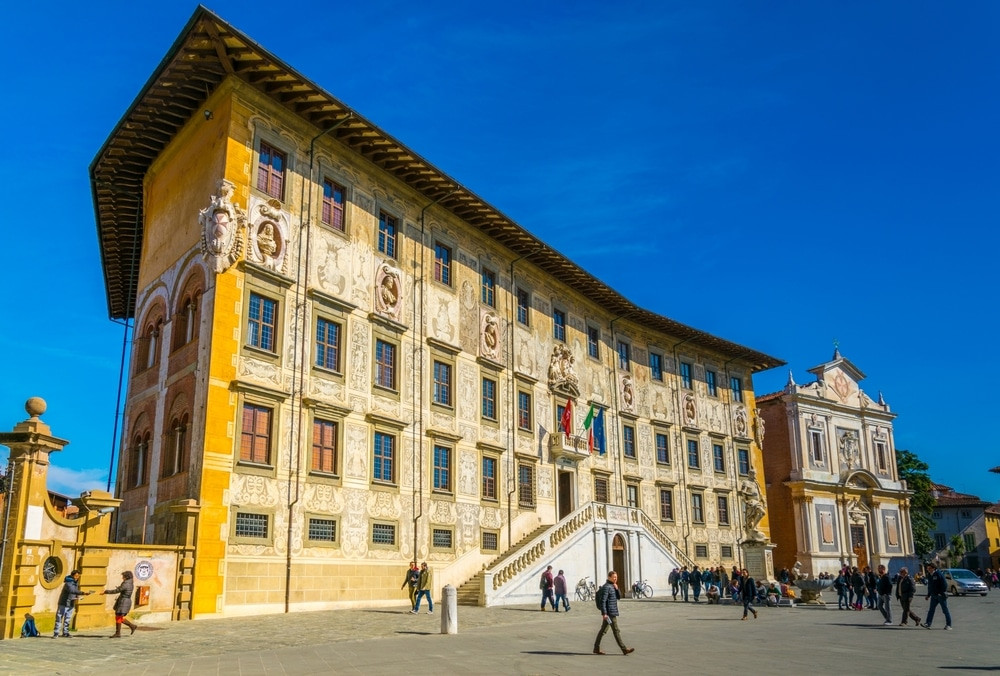
9. Palazzo dei Cavalieri
The most important monument is the Renaissance Palazzo dei Cavalieri. The palace formerly known as the Palazzo della Carovana.
The lovely palace was given an architectural update by Giorgio Vasari in 1562. It served as the palace of the Knights of St. Stephen. It’s now part of Pisa’s University, founded by Napoleon.
The facade is exquisitely frescoed with a pattern called “sgraffiti.” The upper facade has niches with half busts of the Medici dukes. Outside sits a statue of Cosimo I de Medici, just to remind you that Florence conquered Pisa.
There are also several minor museums to check out in Pisa. But by far the best museum in Pisa is the Palazzo Blu.
Every year, the iconic blue building holds exhibitions of important modern artists (Chagall, Dali, Miro, and Toulouse- Lautrec were recently featured). Entry is free, so there’s no reason not to stop in and see what’s on display.
9. Pisa’s City Walls
Pisa’s city walls are the oldest city walls in Italy that remain almost entirely intact. They were built in 1154-61, in the area of the Field of Miracles. The 3 kilometers of ramparts were meant to protect the future Duomo and Baptistery.
There are four entry points. But it’s easiest to access the walls from the Field of Miracles. The cost is only 3 euros.
Tips For Visiting Pisa’s Top Attractions
Pisa is located 20 minutes from the Ligurian Sea in the western region of Tuscany. It’s well connected from the major cities and towns in Italy via train and bus.
Pisa is a short train ride on Tenitalia from the Santa Maria Novella station in Florence. You can also visit Pisa on a half day guided tour from Florence. Or you can combine Pisa and Lucca on a guided tour from Florence.
Most of the trains arrive at Pisa Centrale. The town center and the Field of Miracles are about a 30 minute walk from the train station.
It’s best to visit Pisa in off season to avoid the Leaning Tower crowds. I think it makes sense to explore the town first. Then you’ll arrive at the Field of Miracles later in the day, when some tourists have left.
Here’s my list of tips and everything you need to know before visiting Pisa.
Bottom Line: Is Pisa Worth Visiting?
If you’re desperate to see the mysterious Leaning Tower, then visit Pisa. Just know in advance that the Leaning Tower isn’t the highlight of Pisa at all.
Not even a smidgeon; it’s a folly. There are so many better things to do in Pisa than looking at this overhyped monument to mediocrity.
If you’re an art and architecture lover, Pisa will appeal and you should allot time for the town on your itinerary for Tuscany. The magnificent Field of Miracles, especially with its treasure trove museums, is a veritable art lover’s paradise.
I think it’s worth a full day trip visit, especially if you’re not pressed for time in Tuscany. Stay the night if you want to savor all the details and experience Pisa’s historic center.
If you intensely dislike tourist traps and hordes of tourists, visit during off season for the other goodies. Or steer clear of Pisa entirely in favor of other beautiful Tuscan towns like Siena, San Gimignano, Lucca, or Cortona.
I hope you’ve enjoyed my guide to Pisa’s top attractions. You may enjoy these other Tuscany travel guides:
- 10 Day Itinerary for Tuscany
- 7 Day itinerary for Tuscany
- Must See Sites in Florence
- Best Museums in Florence
- Hidden Gems in Florence
- Best Day Trips From Florence
- Guide To Florence’s Uffizi Gallery
- 1 Day Itinerary for Siena
- 2 Day Itinerary for Siena
- Things To Do In San Gimignano
- Guide to Siena’s Cathedral Complex
- Art Lover’s Guide To Tuscany
If you’d like to day trip to Pisa and see its top attractions, pin it for later.

